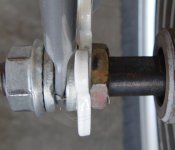SprocketLocket
100 W
Greetings, this is my 1st post in the General forum. Planning my 1st eBike build.
After tons of research, I finally settled on a MAC motor.
My terrain includes many gravel roads (large gravel, not fun even to drive on), so I want to opt for a fatter-tire bike (I don't own a MTB yet). The one I'm probably settling on has 170mm dropouts, Symmetrical spokes, and has 50mm rims (as opposed to the full-fat 80mm rims)... and 7-speed, but having many speeds isn't so important to me (still preferable to 1 speed). Fatter fat bikes like the Mongoose have 180mm dropouts.
I found this comment by wesnewell on his yescomusa kit:
But the MAC diagram shows an axle of 205mm.
http://sdrv.ms/19m6HAh
Is a 205mm axle doable with a 170mm (symmetrical) dropout?
205mm axle - 170mm dropout = 35mm left over.
35/2 = 17.5mm for each nut.
Is this enough?
If it is enough, would there be enough left over for torque arms and/or rack/saddle bag mounts? Advice greatly appreciated.
Can torque arms can be mounted INSIDE dropouts? I imagine there's insufficient room, but would using a narrower cassette provide more room and make it possible, or are they not even shaped right for this?
Fat bikes are the fastest-growing trend in bikes, and seem intrinsically better-suited to motors because the extra dropout width provides more room for stator width, which have been a challenge to fit in 135mm. But I don't see manufacturers adjusting for this trend.
PS: Does anyone know if cell_man's kits come with upgraded wiring by default, or is it by request?
After tons of research, I finally settled on a MAC motor.
My terrain includes many gravel roads (large gravel, not fun even to drive on), so I want to opt for a fatter-tire bike (I don't own a MTB yet). The one I'm probably settling on has 170mm dropouts, Symmetrical spokes, and has 50mm rims (as opposed to the full-fat 80mm rims)... and 7-speed, but having many speeds isn't so important to me (still preferable to 1 speed). Fatter fat bikes like the Mongoose have 180mm dropouts.
I found this comment by wesnewell on his yescomusa kit:
Postby wesnewell » Fri Aug 08, 2014 1:07 am
Most rear hub motors are ~225mm wide. and can fit in dropouts as wide as 180mm leaving ~20mm per side for the axle nut.
But the MAC diagram shows an axle of 205mm.
http://sdrv.ms/19m6HAh
Is a 205mm axle doable with a 170mm (symmetrical) dropout?
205mm axle - 170mm dropout = 35mm left over.
35/2 = 17.5mm for each nut.
Is this enough?
If it is enough, would there be enough left over for torque arms and/or rack/saddle bag mounts? Advice greatly appreciated.
Can torque arms can be mounted INSIDE dropouts? I imagine there's insufficient room, but would using a narrower cassette provide more room and make it possible, or are they not even shaped right for this?
Fat bikes are the fastest-growing trend in bikes, and seem intrinsically better-suited to motors because the extra dropout width provides more room for stator width, which have been a challenge to fit in 135mm. But I don't see manufacturers adjusting for this trend.
PS: Does anyone know if cell_man's kits come with upgraded wiring by default, or is it by request?


